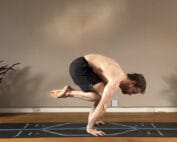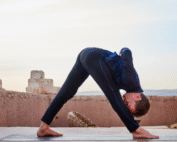
How to do a Four-Limbed Staff Pose (Chaturanga Dandasana)? Tips, Benefits, and Modifications
Let’s dive into mastering the Four-Limbed Staff Pose!
Hi, I’m Dav Jones, and I’m thrilled to guide you through mastering the Four-Limbed Staff Pose (Chaturanga Dandasana). With my years of experience, by carefully following the step-by-step instructions, we’ll explore how to approach Chaturanga through well-informed teachings.
What is the Four-Limbed Staff Pose (Chaturanga Dandasana)?
The Four-Limbed Staff Pose, also known as Chaturanga Dandasana. The Four-Limbed Staff Pose is a foundational yoga posture significant in the modern-day yoga asana practice.
The name, derived from Sanskrit, breaks down as “Chat” (four), “Anga” (limb), “Danda” (staff), and “Asana” (pose), highlighting the pose’s structure where the body aligns parallel to the ground, supported by the toes and hands, engaging the core, arms, and legs.
This alignment and strength are required to symbolize stability and strength, both physically and in one’s yoga practice.
Preparatory Poses for Four-Limbed Staff Pose (Chaturanga Dandasana)
Let’s explore the preparatory poses for the Four-Limbed Staff Pose, or Chaturanga Dandasana. These poses will help us build the necessary strength and flexibility, focusing on our arms, core, and legs. Understanding these warm-ups is key to a successful and safe Chaturanga practice.
List of Poses to Warm Up the Body
1. All Fours Wrist Flexor Stretch
Warming up and stretching the forearm muscles is paramount before load-bearing on the hands.

2. Prone Chest Opener
Lengthening the muscle tissue at the chest and front of the shoulders helps to facilitate increased blood flow to this area of the body and can aid in muscle contraction when it comes to practicing Chaturanga.

3. Cobra Pose (Bhujangasana):
Gently stretches the chest and strengthens the lower back, preparing the spine for the alignment required in Chaturanga.

4. Baby Chaturanga:
This regressed version of Chaturanga with the knees on the mat is a useful variation to practice in building strength for the full expression of the Chaturanga Dandasana.

5. Plank Pose (Phalakasana)
Builds strength in the arms, shoulders, and core, essential for supporting the body in Chaturanga Dandasana.

How These Poses Prepare the Body for Chaturanga Dandasana
Incorporating these preparatory poses into your practice before attempting Chaturanga Dandasana can significantly improve your strength, flexibility, and alignment, making the pose more accessible and effective.
How to do a Four-Limbed Staff Pose? Step-by-Step Guidance.
Let’s dive into the steps of the Four-Limbed Staff Pose, or Chaturanga Dandasana, a key pose for building strength and stability. We’ll cover the fundamental techniques in order to maximise the benefits of the pose and ensure safety in your yoga practice.
Plank Pose:

- Start in Plank Pose: Begin by getting into the Plank Pose. Position your wrists directly under your shoulders. Flex (round) your spine so to contract the ‘six pack’ abdominal and shorten the chest and anterior shoulder muscles.
- Tuck the tailbone under bringing the pelvis into posterior pelvic tilt. Contract the Glute Max muscles.
- Shift Forward: Gently shift your weight slightly forward onto your toes contracting the quadricep (thigh) muscles. This subtle movement prepares your body for the descent.
- Lower Your Body: Depress your shoulders and start to bend your elbows, keeping them snug against the sides of your body. Lower yourself towards the floor until your shoulders are roughly in line with the crease of your elbows. Keep the shoulders depressed throughout the bend of the arms as this helps to keep the shoulder blades and shoulder joints stable.
- Maintain Alignment: Keep points 1 & 2 integrated as you lower your body towards the floor. This requires strong engagement of your core muscles to prevent your chest or hips from sagging. The goal is to keep your whole body integrated in one straight line, from your heels to your head, mimicking the stability and parallel nature of a staff.
- Full Chaturanga Pose:

Full Body Integration: Throughout the pose, keep your shoulders depressed, tailbone slightly tucked, glutes contracted, and remain light on your toes as you lower into the Chaturanga position.
The full Four-Limbed Staff Pose (Chaturanga Dandasana) strengthens the arms, shoulders, and core, enhancing stability and power. It’s a challenging pose that builds foundational strength for more challenging poses in the hand/arm balance family of asana postures.
Four-Limbed Staff Pose (Chaturanga Dandasana) Benefits:
Let’s look at the benefits of the Four-Limbed Staff Pose, or Chaturanga Dandasana. This yoga pose is great for building strength in your arms and core. We’ll also see how it can be good for your overall health, making your yoga practice more effective and rewarding.
Physical Benefits
Mental Benefits
Therapeutic Applications
Anatomy Focus for Four-Limbed Staff Pose (Chaturanga Dandasana)
Muscles Engaged and Stretched
We’re diving into the Anatomy Focus of the Four-Limbed Staff Pose, or Chaturanga Dandasana. We’ll see which muscles this pose activates, from the arms and core to the legs, and how they all work together. Understanding this will help us practice more effectively and safely, highlighting the pose’s benefits and the importance of alignment.
| Engaged Muscles | Anatomical Insights |
|---|---|
| Wrists, Arms, & Chest: Respecting the placement of the hands and wrists helps to feel supported in the postures. Your chest muscles and the back of your upper arms (triceps) work hard to keep you supported. | Why It’s Good for You: Keeping the wrists at a manageable angle for load bearing is paramount for the long-term health of the wrist joint. Have patience and persistence with Chaturanga. It takes time to build strength in the arms and chest by practicing this pose. |
| Placement of Shoulders: Keeping the shoulders is a set position can aid in involving the support of more global (larger) muscles for the posture. | Suggested Shoulder Alignment: Encouraging a depressed shoulder position and a slight posterior tilt of the shoulder blade helps in activating the latissimus dorsi muscles and lower trapezius muscles as you bend the elbows. This alignment suggestion helps to stabilize the shoulder joint and shoulder blade compared to all of the load being placed solely on the upper trapezius and anterior deltoid muscles. |
| Thighs and Buttocks: Your thigh and buttock muscles are also working to keep your legs straight and strong. | Toning the legs and glutes will help the pelvis and legs feel lighter in posture and also take some of the challenge out of the arms. |
Modifications and Props for Four-Limbed Staff Pose (Chaturanga Dandasana)
For Beginners or Injuries:
- Baby Chaturanga (Knees Down): Beginners or those with injuries can modify Chaturanga by placing their knees on the ground. This reduces stress on the arms and wrists.
Cautions and Contraindications
Health Considerations:
- Shoulder and Wrist Issues: If you have shoulder or wrist concerns, proceed with caution or modify the wrists by coming onto the forearms.
- Pregnancy: Consult a healthcare professional about practicing Chaturanga during pregnancy, as it involves core engagement that might not be suitable.
Safety Tips: Always prioritize form over depth and consult with a healthcare provider regarding injuries or conditions that might affect your practice.
Final Thought
Whether you’re taking your first steps into the world of yoga or you’re an experienced practitioner seeking to deepen your skills, our online classes provide tailored instruction for mastering the Four-Limbed Staff Pose (Chaturanga Pose). Connect with Dav Jones Yoga on the Patreon channel or have a look at the DJY Mentorship programs for a more private, tailored approach to exploring your yoga practice. Learn how we can support your journey toward achieving strength, balance, and focus through this powerful posture.









